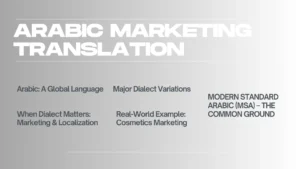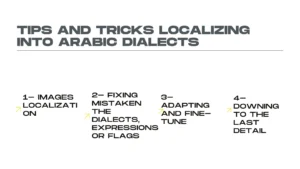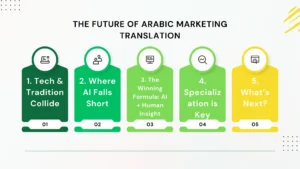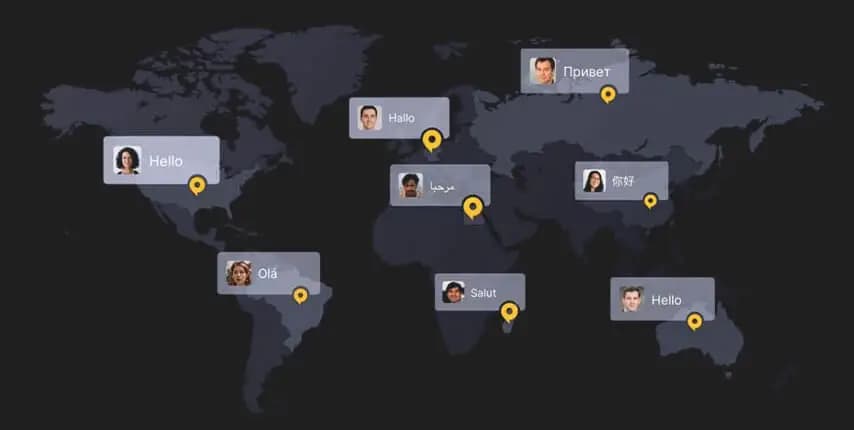Arabic Marketing Translation
Have you translated your Marketing Content into Arabic recently? Are you targeting a certain country
in the Middle East or the Middle East as a region, and does it make a difference when it comes to
localizing into Arabic? Isn’t it one language? At some point, every company selling its products or
services into the Middle East or North Africa has to translate its website, brochures, and marketing
collaterals into Arabic to penetrate and compete in this huge market.
Yes, it is one language, yet the decision that marketing teams should take before translating
marketing materials into Arabic is: who will be the consumer of this content?
 Why Arabic Marketing Translation Matters
Why Arabic Marketing Translation Matters
Arabic is spoken by more than 290 million people worldwide. However, the dialects and accents differ
greatly. The dialect used in Morocco, Tunisia, and Algeria is completely different from that of Egypt,
Libya, and Lebanon, and also distinct from the Gulf region.
Modern Standard Arabic (MSA) is the common ground. It is the form used in newspapers, books, and
broadcast news. The Arabic written in a Lebanese newspaper is the same as in Egypt, KSA, or Kuwait.
But in marketing, adaptation might be necessary to attract specific groups. For instance, adapting
content into Lebanese dialect differs from doing so for KSA or Egypt. This is why the decision of
whether to translate for the Middle East as a whole or for a specific country is crucial.
Modern Standard Arabic vs Dialects
If you are selling cosmetics, the marketing team may decide to translate the website using MSA to
reach as many women as possible. However, for TV Ads, it might be better to use a specific dialect.
Adapting content goes beyond translation—it involves cultural preferences for images, colors,
voice, and design, while maintaining your brand identity. Factors such as language, education level,
traditions, trends, and values of your audience should always be considered.
Tips and Tricks for Arabic Marketing translation
 1. Images
1. Images
People often notice images before text. Revise your images to ensure they do not raise cultural
sensitivities. A good practice is to ask a native speaker to review them.
2. Avoid Mistakes with Dialects, Expressions, or Flags
Confusing dialects can harm your message. For example, in Egypt, milk is called “Laban,” while in
Lebanon and KSA, “Laban” means yogurt!
3. Adapt and Fine-Tune
Stay consistent with local norms so your content feels familiar to your audience. For instance, in
Egypt, Lebanon, and Syria, product names may appear in English or French, while in KSA, trademarks
are typically written in Arabic.
4. Pay Attention to Details
The smallest details—dates, time, currency, phone numbers, and national holidays—can make all the
difference. Proper localization adapts these to the target audience’s expectations.
 The Future of Arabic Marketing Translation
The Future of Arabic Marketing Translation
1. Tech & Tradition Collide
AI and machine translation are shaking up Arabic localization.
Faster? Yes. Smarter? Not yet—marketing needs more than raw speed.
2. Where AI Falls Short
- Misses cultural cues, tone, and emotional triggers.
- Struggles with wordplay, humor, and brand personality.
3. The Winning Formula: AI + Human Insight
Let AI handle bulk translations and rough drafts.
Bring in skilled transcreators to fine-tune messaging.
Result? Content that’s fast, culturally sharp, and on-brand.
4. Specialization is Key
Generic translators won’t cut it anymore.
- Tech firms need linguists who speak “developer.”
- Fashion brands demand translators fluent in trends and textiles.
5. What’s Next?
Expect tighter AI-human collaboration.
Niche expertise will dominate premium translation.
Brands that blend tech efficiency with human creativity will win.
Conclusion
Yes, Arabic is one language, but buying behaviors vary across regions. Successful Arabic marketing
translation is about balancing Modern Standard Arabic with localized adaptations that resonate with
your specific audience.









